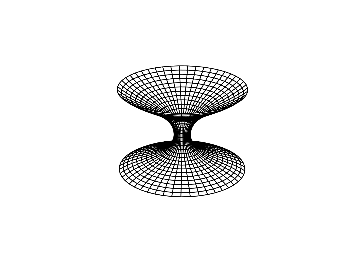This article explores the concept of wormholes as a means of intergalactic or interdimensional travel, delving into their theoretical basis and scientific implications. The conditions required for a wormhole to be traversable and stable, including the role of phantom energy, are explained. While stable, traversable wormholes are currently considered to be within the realm of science fiction, some theories suggest the possibility of microscopic wormholes existing in quantum foam. The article acknowledges the challenges associated with finding and utilizing wormholes and emphasizes the scientific value of studying these structures. Despite the current limitations, understanding wormholes could revolutionize space travel and expand our understanding of the Universe.
Keywords: wormholes, astrophysics, dimensions, space exploration, theoretical physics.
Indeed, the concept of trips to other galaxies or dimensions becoming as commonplace as going to the supermarket and movies about space travel coming to life is an intriguing idea that sparks the imagination. However, when it comes to the reality of such possibilities, we enter the realm of theoretical physics and scientific speculation. One fascinating concept that has captured the attention of both scientists and science fiction enthusiasts is the idea of wormholes.
A wormhole, as mentioned earlier, is a hypothetical astrophysical object that distorts space and time, potentially enabling travel between distant points in the universe or even between different dimensions. To understand the basic principle behind a wormhole, one can visualize it using a simple analogy. Take a sheet of plain paper, bend it in half, and then pierce it with a pencil. The resulting hole represents a simplified representation of a wormhole, with one side of the sheet acting as the entrance and the other as the exit.

Fig. 1. Wormhole visualization
The visualization of wormholes gained mainstream attention with the release of the movie «Interstellar» in 2014. Directed by Christopher Nolan in collaboration with physicist and Nobel laureate Kip Thorne, the film depicted the main characters embarking on a journey through a wormhole from our Solar System to another galaxy. This portrayal sparked widespread curiosity, prompting many people to question whether such extraordinary trips could be possible in the future.
The concept of wormholes traces back to the foundational work of the renowned physicist Albert Einstein. In his theory of general relativity, Einstein proposed that gravity is not merely a force that attracts matter, but rather a curvature of space and time caused by massive objects like planets and stars. Building upon this idea, Einstein, along with the American scientist Nathan Rosen, suggested in 1935 that it might be conceivable to create a tunnel-like connection between two distant regions of space by bending and connecting the fabric of space-time itself. This theoretical construct became known as a wormhole.
For a wormhole to be traversable and stable, certain conditions need to be met. One crucial factor is the presence of what is called phantom energy. In simple terms, phantom energy refers to a form of dark energy that possesses negative pressure, causing the expansion of the Universe to accelerate. This mysterious and largely unknown form of energy constitutes a significant portion of the total energy density in the Universe. While the concept of phantom energy remains a subject of ongoing research and investigation, it represents a potential ingredient for stabilizing a wormhole, preventing the collapse of its neck under the powerful influence of gravity.
Despite these fascinating theoretical possibilities, finding and utilizing wormholes remains a significant challenge. If wormholes do exist in our universe, they are likely to be exceptionally small and highly unstable. In fact, the notion of a stable wormhole traversable by humans and objects is currently considered to be within the realm of science fiction. According to Kip Thorne's book, «The Science of Interstellar», astronomers have not discovered any object in the universe that can be definitively identified as a wormhole, while numerous massive stars have been observed to undergo gravitational collapse, leading to the formation of black holes. [1, p. 134]
Nevertheless, there is a glimmer of hope within the scientific community. Some theories propose that wormholes could exist on a microscopic scale within the fabric of space-time known as quantum foam. Quantum foam is a concept put forth by physicist John Wheeler in 1955 to describe a turbulent sea of fluctuating energy and matter at incredibly small scales. If we were to zoom in to the Planck length, which is approximately 10– 33 centimeters and represents a hundredth of a billionth of a billionth of the size of an atomic nucleus, space-time might resemble a frothy foam. Within this foam, Wheeler suggested the existence of minuscule wormholes that could potentially be enlarged and manipulated. This idea implies that by extracting and enlarging a tiny wormhole from the quantum foam, it might be feasible to create a larger, traversable wormhole. The challenge of keeping such a wormhole stable and preventing its collapse would still remain, potentially requiring the enigmatic properties of phantom energy. [1, p. 135]
Despite the current limitations and uncertainties surrounding the practical realization of wormholes, the study of these fascinating structures holds significant scientific value. Exploring the nature of wormholes and their theoretical implications contributes to a deeper understanding of fundamental physics and the underlying fabric of the Universe. Furthermore, the potential existence of traversable wormholes could revolutionize space travel, opening up extraordinary possibilities for human exploration and venturing into regions of the cosmos that were previously considered unreachable.
In conclusion, the concept of wormholes as a means of intergalactic or interdimensional travel captures the imagination and raises intriguing questions about the nature of space and time. While wormholes remain largely in the realm of theoretical physics and science fiction, ongoing research and scientific inquiry contribute to our understanding of these enigmatic structures. The pursuit of knowledge in this field not only expands our horizons but also has the potential to shape the future of space exploration, offering new frontiers and possibilities that were once confined to the realm of fiction.
References:
- Kip, Thorne. The Science of Interstellar. — W. W. Norton & Company, 2014. — 336 p.







